TL;DR
Guest posting means publishing content on trusted websites in your niche to reach new audiences, build authority, earn backlinks, and drive qualified referral traffic back to your site.
The biggest benefits of guest posting include increased brand visibility, stronger SEO through high-quality backlinks, referral traffic that converts, and long-term credibility in your industry.
Successful guest posting starts with clear goals. Whether you want traffic, backlinks, leads, or authority will determine which sites you target, what topics you pitch, and how you structure your author bio.
Finding the right sites matters more than volume. Focus on relevant blogs with engaged audiences and solid authority, not sites that accept anyone willing to submit a post.
Personalized outreach beats templates. Building relationships, understanding the site’s audience, and pitching tailored ideas dramatically improves acceptance rates.
High-quality content is non-negotiable. Guest posts should match the host site’s tone, provide original insights, and be useful enough that the publisher is proud to feature them.
Your author bio is where results compound. Linking to a targeted landing page or lead magnet with a clear CTA turns guest post traffic into subscribers and customers.
Promotion and tracking are essential. Promoting guest posts and tracking performance with UTM links, GA4, and conversion tools helps you identify which placements actually drive ROI.
If you’re serious about growing your brand, building backlinks, and driving qualified traffic, guest posting is still one of the most powerful (and underutilized) strategies in digital marketing.
With AI content everywhere and Google cracking down on low-quality links, it is fair to ask whether guest blogging still works in 2026. The short answer is yes if you do it right.
When focused on quality, relevance, and real value, guest blogging remains one of the best ways to grow visibility, build authority, and reach new audiences. This step-by-step guide shows you how to make it work today.
Note: Throughout this article, the terms ‘guest posting’ and ‘guest blogging’ are used interchangeably, as they convey the same meaning.
What Is Guest Posting and Why It Is Still Effective
Guest posting is when you write and publish an article on someone else’s blog or website, typically in your industry or niche. It’s a way to share your expertise with a new audience, build backlinks to your own site, and grow your authority as a content creator or business.
By writing guest posts on blogs, you can improve on the following:
- Referral Traffic: Boost referral traffic and content marketing ROI by driving traffic from other reputable sites.
- Brand Awareness: Introduce your brand to new audiences through content on other sites.
- Lead Generation: Attract new subscribers and improve lead generation due to new readers visiting your site or landing page.
- Social Proof: Gain credibility when trusted, authoritative sites publish your content.
- SEO Link Building: Obtain backlinks from high-quality sites, a key SEO ranking factor.
- Content Marketing: Guest posting helps website owners meet their content needs, addressing a major content marketing challenge.
Remember, the success of guest posting largely depends on the quality and relevance of the content, as well as the reputation of both the guest blogger and the host site.
Related Content Ultimate List of Blogging Statistics and Facts
How Guest Posting Works in Practice
Here’s the step-by-step tutorial you need to follow to do guest posting successfully:
- Know Your Goals
- Find Guest Posting Opportunities
- Guest Post Outreach
- Choose a Winning Guest Post Idea
- Submit Your Pitch
- Write Great Content
- Work That Bio
- Be Responsive
- Promote Your Content
- Write More Guest Posts
- Track Success
Step 1. Know Your Goals
Like every other marketing strategy, a successful guest blogging strategy starts with knowing your goals. After all, you have to know where you’re headed if you ever expect to get there.
The typical goals for a guest blogging strategy align with the benefits described earlier. They include:
- Driving traffic to a specific landing page (or to your site in general) to get more leads and sales
- Building awareness of your brand, products, and services
- Improving SEO by attracting inbound links
- Positioning yourself as an expert so you can be cited more often and get speaking engagements
- Increasing email subscriber numbers or your social media audience
It’s essential to have a goal in mind so you can frame your author bio appropriately and ensure that your links deliver what you’ve promised. It’s the best way to build trust with the new audience you’re attracting.
Step 2. Find Guest Posting Opportunities
TL;DR: Use search operators, social media, and backlink tools to discover high-authority blogs that accept relevant guest posts.
Before you write a guest blog, you’ll have to find a site that accepts guest authors and is actively looking for content. Beyond that, you’ll need to ensure that posting on the site will help you meet your goals.
How to Find a Site That Accepts Guest Posts
There are lots of ways to find sites that are happy to accept guest posts.
For example, you can use Google to find sites that accept guest posts on the topics you want to write about. Some sample search queries include:
- [topic keyword phrase] + “write for us”
- [topic keyword phrase] + “guest article”
- [topic keyword phrase] + “become a contributor”

These queries should direct you to a blog’s guest post guidelines page, guest post submission page, or actual guest pieces from other contributors.
See this list of search queries from Optimize Smart for even more suggestions.
You can also use similar queries on Twitter. Just type “guest post” or “guest article” into the search box, and you’ll see a list of tweets showing guest posts.

Whether you’re using Google, Twitter, or another search source, make a note of the guest blogging sites. You’ll need those later when it’s time to see if the opportunity is right for you.
You can also find guest posting opportunities by checking out where your competitors are guest posting. Most guest bloggers will share their posts to enhance their reputation. When you follow competitors on social media or subscribe to their email newsletter, you’ll likely see links to their guest posts.
Another way to find this information is to see where their inbound links are coming from. To do this, log in to Semrush (Ahrefs is also a good alternative), and go to Backlink Analytics. Type the URL of the competitor site you want to check into the search box. Then select the Backlinks tab.
When you get the report, you’ll be able to see the actual backlinks, the anchor text, the referring domains, and more. Look for the dropdown menu that says Ref. page platform and change the platform to Blog. This will narrow the results down to blog sites, and some of these backlinks may be from guest posts.

This information will help you find more sites that accept guest posts. For more information on using Semrush for guest blogging research, see their article on How to Guest Post for SEO
Other places to find guest posting opportunities for your guest blogging strategy include:
- Alltop, which lists the top guest posting sites in almost every niche
- Lists of sites that accept guest posts, like this one
- Checking out where the most prolific bloggers in your niche are guest posting
How to Assess Guest Blogging Opportunities
Finding the sites is only one part of the equation. You also have to figure out if those sites are worth your while and will help you meet your goals. Most importantly, you should choose sites that aren’t spammy. Publishing on spammy sites can hurt your guest blogging SEO.
Here are some areas to assess. Pick one of the sites you identified above to get started.
Domain Authority
First, use Moz’s Link Explorer to check the domain authority for the site you’re considering. This tactic tells you if the site is well-regarded online. It’ll also give you an idea of whether guest blogging on that site will provide good value in terms of links and referral traffic. Here’s a domain authority report for the Content Marketing Institute as an example.

The higher the number (on a scale of 0 to 100), the better.
There’s no clear benchmark for what is a “good” domain authority score. The average will vary based on industry and the size of your niche. But as you’re comparing potential sites to guest post for, it’s a smart idea to prioritize the ones with the highest domain authority.
You must create an account to use Moz’s Link Explorer. The free account allows a limited number of searches per month. Pricing for Moz Pro starts at $99 per month
Follower and Subscriber Count
You should also check for the brand’s email subscriber and social follower numbers. Most site owners publish these if they’re big enough, and it’ll give you an idea of the size of the potential audience you could reach.

If social follower numbers aren’t on the site, check out their social media profiles yourself and see if the website owners have an audience, and whether they actively promote all content published on their site (including guest content). If you look back over a month’s worth of content, you’ll see whether they regularly post links to blog posts.
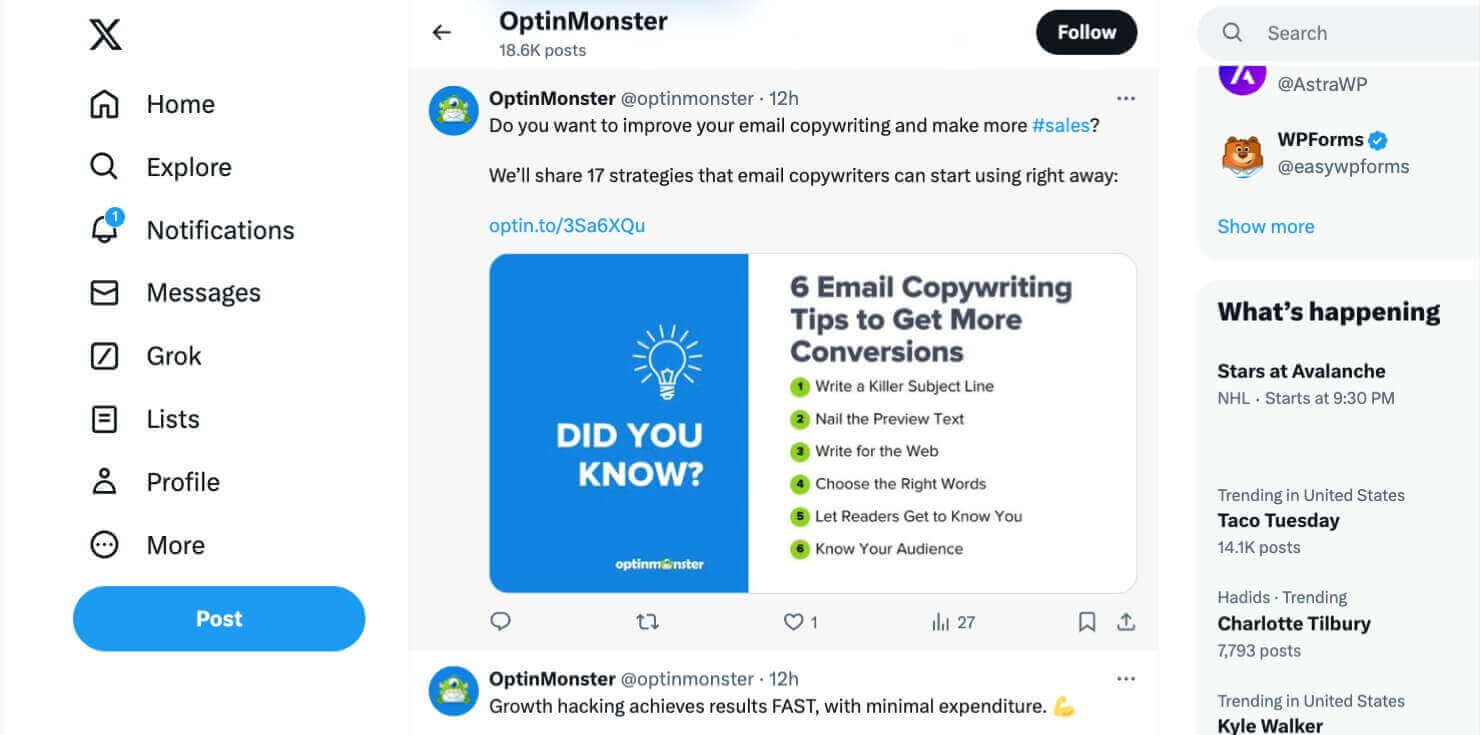
Blog Content
Next, look at the content of the website’s blog. See if the content published is a match for the topics you want to write about. Don’t worry if comment numbers are low; that’s true of many sites these days. And even if the number of social shares isn’t impressive, a site that reaches your ideal target audience can still help you meet your goals.
Check out the author bios at the end of guest posts, to make sure you’ll be able to get appropriate credit and send readers back to your site, as in the example below from the OptinMonster blog.

We’ll look at how to create a great guest blogging bio later in this guide.
Step 3. Guest Post Outreach
TL;DR: Build real relationships before pitching — engage with the blog’s content and community first to stand out.
Before you approach site owners to suggest a guest post (known as “pitching”), you’ll need to form a connection with them.
Don’t be fooled by all these guest blog post pitch templates you see online. For most site owners, cold pitches won’t work unless the content is stellar.
In fact, many website owners are so tired of irrelevant pitches and poor quality content that they’ll only take guest content from people they already know, like, and trust. Here’s how you can become one of those people.
First, get to know their site and the type of content they publish by following them on social media, where many people share their content, or by subscribing to their site in Feedly, so you get updated whenever there’s something new.
Read the content consistently for a few weeks, or longer, so you understand what matters to them and their audience. If they list their top-performing or featured content on their site, check that out, too. For example, anyone visiting WPBeginner can easily see what kind of content is most popular by looking at the sidebar:
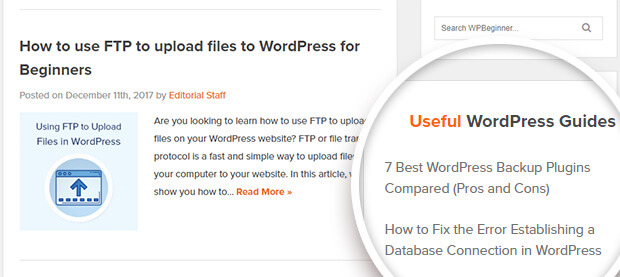
Connect with site owners on social media, so you can tag them when you share their site content. Share anything you really love and include a comment so it’s not just a plain link.
Comment on their blogs, sign up for their email marketing newsletter, and respond to their emails.
The point is to build a relationship with the site owner. Don’t fake it; they’ll figure it out and you won’t achieve your goals.
Step 4. Choose a Winning Guest Post Idea
TL;DR: Research what’s already popular on your target blog and pitch a fresh, high-value angle that aligns with their audience.
Once you have a good understanding of your target site, and what matters to the site owner, it’s time to find a topic to pitch.
You should already know what’s popular on the site. Now, think about how you can add value by:
- Responding to what’s on the site
- Providing additional information on a popular topic
- Writing something new on a topic that’s likely to be popular with the audience
When you’re ready to narrow your choice, Buzzsumo is a great tool to use. With Buzzsumo, you can search for the most shared content on a specific site, within your industry, or within a general topic.

You can use these results to discover what blog topics readers are likely to share. When more readers share your guest post, your brand will get more reach.
If you find a topic that’s widely shared, and relevant to a site, but hasn’t yet been published on your target site, that’s a good topic to kick off your guest blogging strategy.
Buzzsumo has a 30-day free trial. After that, pricing starts at $199 per month.
Looking for an edge when choosing your topic? Research shows that in-depth content, posts that use proprietary research, and posts that share experiences and life hacks tend to be popular.
Important note: Before pitching a guest blog topic, make sure the site doesn’t already have a post about it. If the blog has a search bar, search for a few related keywords to see what posts they already have. You can also use the Google operator site: xyz.com to search for results within that website. While you want to create posts similar to the site’s most popular content, you shouldn’t pitch specific topics that have already been covered.
One last thing: if the site has guest post guidelines for pitching and writing, read them. If you don’t, website owners might just reject your pitch before even reading it.
Step 5. Submit Your Pitch
TL;DR: Personalize your email, lead with a strong headline, and explain exactly how your content will benefit their readers.
For a successful guest blogging strategy, it’s important to avoid generic guest posting pitches. If you’ve done your homework as we suggested earlier, you’ll be able to craft a winning pitch that’s personal to each site owner with very little effort.
The first rule is to keep the pitch short and to the point. Site owners, especially those with authoritative sites, get a LOT of pitches, so don’t waste their time.
Second, use their name – most site owners won’t read pitches from people who can’t be bothered to research this basic contact detail.
Third, include the post title. In fact, some successful pitches use this in the email subject line and as a secondary heading within the body of the email.
Your Buzzsumo results also give you a snapshot of popular headlines. Use this as a starting point for coming up with your own, and nail the right headline with this list of headline tools. If the person you’re pitching loves your title, you’re halfway to a successful pitch.
Next, describe the post briefly. Say what it will cover in a couple of sentences or a few bullet points.
Say how this piece of content will help their readers. Since by now you’re familiar with their existing content, this will be easy to do.
Finally, show why you’re the right person to write the post. Note, this isn’t a resume; just hit a couple of high points.
Here’s one example of how this would work.
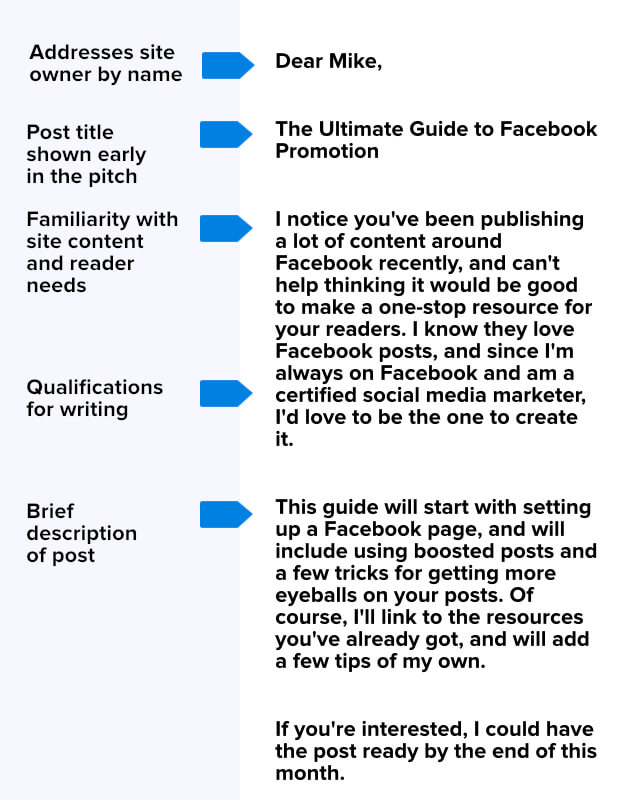
Remember, this is not a guest posting template. Craft your own unique pitch for the site you want to reach, using your own natural tone and language.
Step 6. Write Great Content
TL;DR: Match the host blog’s tone and format, include helpful internal/external links, and optimize for both SEO and user experience.
If your pitch is accepted, the next thing to do is write your guest post. Especially if it’s the first time you’re writing for a site, you want to make it better than your best.
Craft a Stellar Headline
Start by taking a look at the headline in your pitch again. Even if the site owner loved it, it won’t hurt to come up with some alternatives. Some of the best headlines:
- Include the benefit for the reader
- Use action words
- Tap into emotion
We use headlines like those on the OptinMonster blog, and our readers love them! Here’s a guide to writing great headlines to help you nail yours.
Research Keyword Phrases
Website owners will love it if your guest content ranks well in search engines and drives organic traffic to their site. So, just like you’d do for your own content, carry out some keyword research to find a couple of core phrases you can use to optimize it.
Good keyword usage (not stuffing) shows search engines that content is relevant, which helps searchers find it – and you. Read our full keyword research guide for help with this.
Link Appropriately
Ideally, your guest post will have a great link profile, which helps with SEO and building authority. That means you should include relevant internal and external links in the guest post you’re writing.
Within the content, link to great content from the site you’re writing for, and useful resources on external sites. This helps give the content a good link profile, which is also good for SEO and building authority.
Make sure you follow any linking guidelines set out by site owners. As you’ll see when we get to the bio section, some limit links.
Include Images
Finding images can be a hassle, so unless site owners prefer to do this themselves, help them out by including or suggesting relevant images for your guest post. These will underline your main points and break up the text to make it easier for readers to scan. Use our guide to free image sites to help get high-quality images for your guest blogging strategy.
Format the Post Correctly
Finally, format the post so it matches others on the site. Note how they use subheadings, capitalization, bold text, lists, etc. The less work you leave for site owners to do, the happier they’ll be to keep working with you. Some sites provide guest post guidelines for guest post writers, in which case, all you need to do is follow them.
Step 7. Work That Bio
TL;DR: Use your author bio to drive traffic and leads by linking to a landing page with a clear CTA and optional lead magnet.
The bio is the payoff for the hard work you’ve invested in your guest blogging strategy. That’s because it’s where you get to link back to your own site and resources. Options commonly offered include:
- A single link to your home page
- A link to any page/resource on your site
- A link to your site plus a social media link
- A couple of web and social media links
There are even a few site owners who put no restrictions on links in the bio, though that’s not very common. In most cases, you’ll be able to link to a URL of your choice plus a social link.
How to Use Your Bio for Lead Generation
If you get the choice, consider improving lead generation by linking to a landing page with a lead magnet, so you get signups from people who already like the content you’ve written and want to learn more. Here’s an example of that guest blogging strategy from Adam Connell on Blog Boost Traffic:

OptinMonster is a great way to deliver your lead magnet. Follow our guide to creating your first campaign, then visit the Success tab in the OptinMonster campaign builder. You can deliver the lead magnet immediately via a success theme or a link, and can also send it by email.
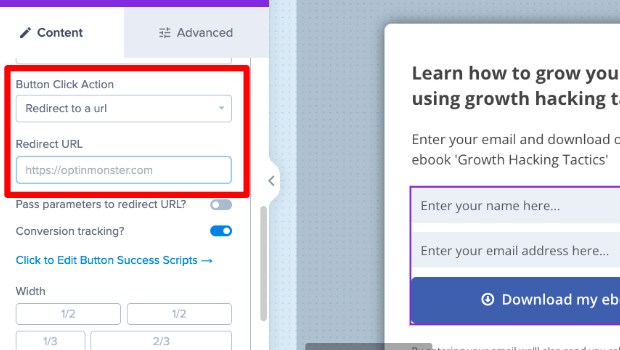
Whether you’re linking to a landing page or not, include a clear call to action (CTA) so readers know what to do next. A typical guest posting CTA can ask readers to:
- Visit your site
- Download a free resource
- Follow you on social media
OptinMonster’s Referrer Detection feature is another useful way to capitalize on traffic resulting from your guest blogging strategy. It allows you to show specific campaigns to people coming from a particular site, without needing to create a whole landing page.
Follow our instructions for creating your first campaign, then go to Display Rules » Current URL path » exactly matches. Add the URL of your guest post.

You’ll be able to track the success of your campaign in OptinMonster’s conversion analytics dashboard.
Another approach to the bio is to define your target audience. Say who you work with and how you can help them, as in the example from Cate Scolnik below:

If you can, add UTM parameters so you can check the success of each guest blog in Google Analytics. That’ll tell you which sites are really working to meet your goals. You’ll be able to track the traffic coming from different sites within your GA4 dashboard.
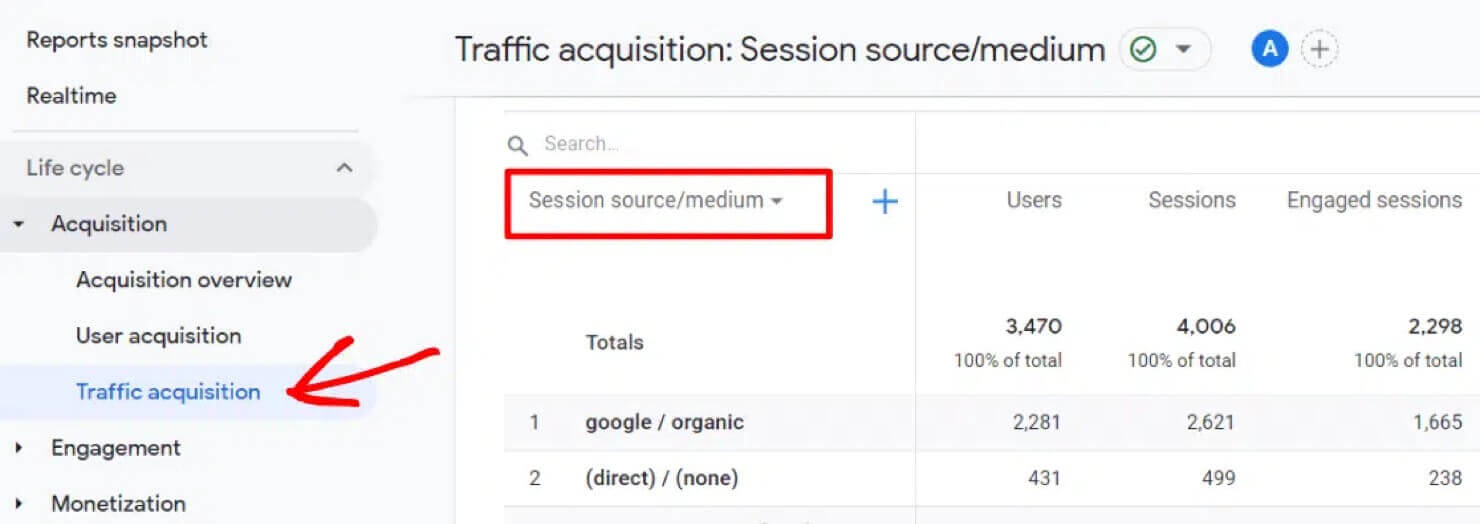
If you have a WordPress site and want an easier way to track UTM links, try MonsterInsights.
MonsterInsights brings the power of Google Analytics to your WordPress dashboard with an easy-to-use interface. That’ll save you time and stress.
MonsterInsights starts at just $99.50 a year, and there’s a 14-day money-back guarantee.
Finally, there’s no rule that your guest posting bio has to be identical on every site. Don’t be afraid to change your bio depending on your goals. Here’s one bio for a travel site:

And here it is customized for a productivity site:

Step 8. Be Responsive
We’re going to keep this next guest blogging strategy tip short and sweet: keep an eye on the comment section and respond to comments and mentions of your post.
Why? Not just because it’s good manners, although that’s a good reason. Being responsive is how you make connections with your new audience, which can help you meet some of your strategic goals.
Blog owners will also be happy if you’re responsive, making it more likely they’ll be receptive to new pitches, or will suggest ways you can contribute further. This moves you even closer to achieving your goals for your guest blogging strategy.
If the blog owner allows it, subscribe to comments on your guest post, so you’ll get an email alert when anyone comments. You can also track mentions and shares of the post via a Google alert.
Step 9. Promote Your Content
TL;DR: Amplify your guest post through email, social, and repurposing — more traffic means more authority and ROI.
Content promotion is a key part of your guest blogging strategy so more people read your content and follow it back to your site. The site owner will be happy to benefit from increased traffic, too.
You can promote guest posting content via the same channels you use to promote your own content. For example, you can inform subscribers about your guest blog in your email marketing newsletter. You can even include links to your best posts in any drip email campaigns you have scheduled.
You should also share your content on social media. If you’re promoting content via Buffer or another social scheduling platform, add your guest post links to your queue. Remember, not everyone will see your social media post the first time, so reshare your guest posts several times.
Wherever you share your guest posts, encourage your subscribers and followers to visit, comment, and share. Some will be happy to oblige.
Finally, link to and mention your guest blog content whenever it makes sense, both in posts on your own blog and on other guest posts, which brings us to the next point:
Step 10. Write More Guest Posts
While one guest post will help you achieve some goals, for real success you need to keep writing more. With a good guest blogging strategy, more is more, as long as you can maintain high-quality guest articles.
The more posts you write, the more online presence you’ll have, and the more people will see you as an authority. That leads to more invitations to write and participate in events, more organic traffic to your site, and more leads and sales.
Of course, if you’re writing a lot of guest posts, you’ll need a way to keep track of them. That’s why it makes sense to have a guest posting calendar.
An easy way to do this is to create a new calendar in Google Calendar and add the titles and due dates of any guest blogging commitments.
If you’re writing for a few publications regularly, use color-coding to have an easy visual guide to what’s coming up for which sites. You can even note when posts are scheduled to be live, so you can kick social media promotion into high gear.
Other tools for tracking your blogging commitments include Asana and CoSchedule.
Step 11. Track Success
TL;DR: Use UTM links, Google Analytics, and OptinMonster’s conversion data to measure which guest posts drive real results.
If you want to know if your guest blogging strategy is working, you’ll need to measure success. This means using some of the tools mentioned earlier in this guide.
For example, if you want to see if your content is bringing in more leads, track traffic to your landing page with Google Analytics, and use OptinMonster’s conversion analytics to assess the success of your marketing campaigns.
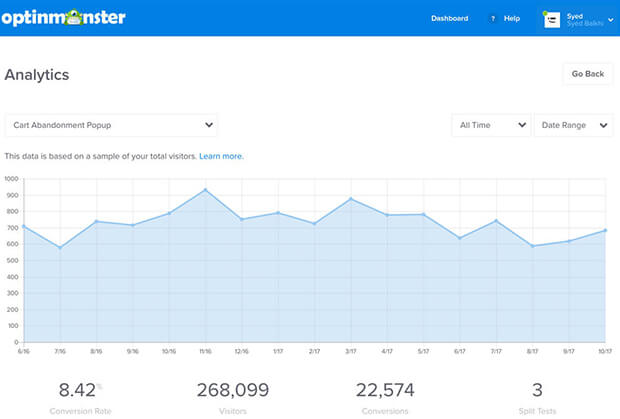
Search Buzzsumo as described earlier to see if your guest content is being shared on social media. Buzzsumo also lets you set up an author search so you can track all your guest content from one place. To do this use author: [your author name] in the search box.
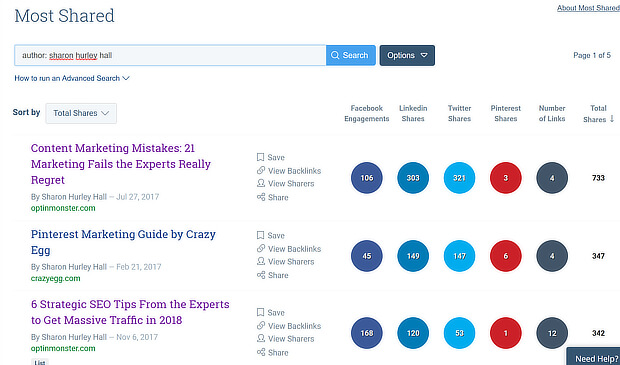
Use Semrush as described earlier to see how your guest content ranks for target keywords and if you’re getting new inbound links and related traffic from your guest posts.
Lastly, remember to follow up with the blog owner or editor. Thank them for the chance to contribute and ask if they have any feedback or potential opportunities for future collaborations.
How OptinMonster Uses Guest Posting to Grow Traffic and Trust
Here’s how we’ve used guest posting to expand our reach, generate leads, and earn authority-building backlinks from top industry blogs.
Where We’ve Guest Blogged
Our content team and contributors have published guest posts on:
- WPBeginner – One of the largest free WordPress resources online
- Blogging Wizard – A go-to platform for content creators and marketers
- WPForms Blog – A trusted source for WordPress tips and lead generation tactics
Each of these placements was strategic, targeting high-authority sites with engaged audiences that overlap with our core customer base.
What Guest Blogging Has Delivered
From these placements and others, we’ve seen real, measurable results:
| Metric | Performance Impact |
|---|---|
| Referral Traffic | Up to 12% lift in targeted traffic during campaign weeks |
| Email Signups | 18–25% conversion rate on linked lead magnets |
| SEO Value | High-quality backlinks improved rankings for key conversion-focused pages |
| Brand Mentions | Boosted brand recall in WordPress and marketing communities |
For example, our WPForms guest post on list-building tactics consistently drives traffic to our own list-building templates with an average time on page of 3.7 minutes.
Why It Works
We follow the same process we outline in this guide:
- Personalized outreach (not generic pitch blasts)
- Highly relevant, high-value content tailored to each audience
- Clear CTAs with lead magnets customized to the guest post topic
- Post-publish promotion to maximize visibility
And because we track every campaign using UTM parameters and OptinMonster’s Referrer Detection, we know exactly which placements convert and which ones to scale.
FAQ – Guest Posting
1. What is the best way to track guest post ROI?
Use UTM parameters for every link you include in a guest post, and monitor results in Google Analytics. For deeper insights, tools like MonsterInsights can help track referral traffic, conversions, and time on site from each guest post.
2. Can guest blogging hurt SEO if done wrong?
Yes, if you’re posting on low-quality or spammy sites, it can negatively affect your SEO. Avoid sites with low domain authority or excessive outbound links. Google has warned against manipulative link schemes, so focus on value, not volume.
3. How do I choose the best sites to guest post on?
Look for blogs that:
- Serve your target audience
- Have engaged readers (comments, shares)
- Offer followed links in bio or content
- Have DA 40+ (check with Moz, Semrush, Ahrefs)
4. What should I include in a guest author bio?
Your bio should:
- Clearly explain who you are and what you do
- Link to a custom landing page or lead magnet
- Include a call to action
- Optionally link to one social media profile
5. Is guest posting still effective in 2025?
Absolutely. Guest blogging remains one of the most trusted strategies for earning backlinks, building brand awareness, and generating leads especially when combined with lead capture tools like OptinMonster.
6. What is a Guest Blog Post?
A guest post is an article or piece of content written by someone who is not a regular contributor to a website or blog. Instead, the content is contributed by an external writer, often aiming to promote a particular message or brand.
That’s it. By following this guest posting guide, you’ll be ready to become a successful guest blogger.
Guest posting stands out as a tried-and-true strategy to boost brand visibility, establish authority, and foster meaningful industry connections.
But remember, the success of your guest blogging efforts is often tied to the tools you use to convert that newfound traffic into loyal subscribers or customers.
If you’re looking to supercharge these conversions, consider OptinMonster.

With its intuitive design and powerful features, it’s no wonder many successful bloggers and marketers trust OptinMonster to optimize their guest blog returns.
As you venture into the world of guest blogging, ensure you’re equipped with the best tools to maximize your efforts. Happy blogging!
Get started with OptinMonster today!
Related Resources:











Add a Comment